| Listing 1 - 10 of 28 | << page >> |
Sort by
|
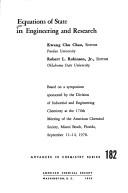
ISBN: 0841205000 Year: 1979 Publisher: Washington : ACS - American Chemical Society,
Abstract | Keywords | Export | Availability | Bookmark
 Loading...
Loading...Choose an application
- Reference Manager
- EndNote
- RefWorks (Direct export to RefWorks)
Engineering mathematics. --- Equations of state. --- Engineering. --- Fluids. --- Equation of state --- Thermodynamics
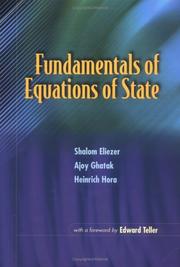
ISBN: 9812778136 9789812778130 9789810248338 9810248334 9810248334 Year: 2002 Publisher: River Edge, N.J. : World Scientific,
Abstract | Keywords | Export | Availability | Bookmark
 Loading...
Loading...Choose an application
- Reference Manager
- EndNote
- RefWorks (Direct export to RefWorks)
The equation of state was developed for ideal gases & proved central to the development of early molecular & atomic physics. This book is an account of the equation of state & its applications in theoretical physics, chemistry & engineering.
Equations of state. --- Equation of state --- Chemistry, Physical and theoretical --- Matter --- Properties
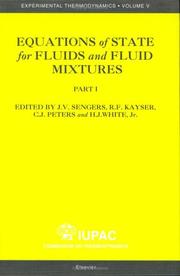
ISBN: 9780444503848 0444503846 0080531180 9780080531182 9786611059644 1281059641 Year: 2000 Publisher: Amsterdam ; New York : Elsevier,
Abstract | Keywords | Export | Availability | Bookmark
 Loading...
Loading...Choose an application
- Reference Manager
- EndNote
- RefWorks (Direct export to RefWorks)
This book has been prepared under the auspices of Commission I.2 on Thermodynamics of the International Union of Pure and Applied Chemistry (IUPAC). The authors of the 18 chapters are all recognized experts in the field. The book gives an up-to-date presentation of equations of state for fluids and fluid mixtures. All principal approaches for developing equations of state are covered. The theoretical basis and practical use of each type of equation is discussed and the strength and weaknesses of each is addressed. Topics addressed include the virial equation of state, cubic equation
Fluids. --- Equations of state. --- Equation of state --- Chemistry, Physical and theoretical --- Matter --- Hydraulics --- Mechanics --- Physics --- Hydrostatics --- Permeability --- Properties
Dissertation
Year: 2020 Publisher: Liège Université de Liège (ULiège)
Abstract | Keywords | Export | Availability | Bookmark
 Loading...
Loading...Choose an application
- Reference Manager
- EndNote
- RefWorks (Direct export to RefWorks)
A discussion of the different types of hypersonic wind tunnels, with their capabilities and limitations is provided. The method used for the duplication of the conditions encountered during the reentry is highlighted in the specific case of the measurement of the aerodynamic parameters. A special attention is then given to the Galileo probe mission and the future mission to the Icy Giants. In order to increase the simulation capabilities of the Longshot wind tunnel, different gases are proposed to duplicate the conditions encountered during an atmospheric entry. Hydrogen, argon, oxygen, air, methane and a mixture equation of state are presented. The thermodynamic results are compared to the reference data provided by the Nist or the experimental measurements. These equations of state are accurate on a large temperatures and pressures range. The mixture equation is tested for several concentration of oxygen and nitrogen with the same type of error in all the cases. Hydrogen safety recommendations highlight the flammability and detonability hazard of this gas. The second risk of this gas is linked to the embrittlement this gas causes in several materials. Health hazards are limited to the general asphyxiant risks. A series of simulations using hydrogen as test gas is performed inside a L1D program that simulate the behaviour of the gas inside the Longshot. The behaviour of hydrogen differs from nitrogen. The velocity of the shock wave, the maximum temperature and the maximum pressure are higher in the case of hydrogen, while the compression due to the passage of the shock is far lower than when using nitrogen. New initial conditions should be designed for a pertinent use of hydrogen inside the Longshot.
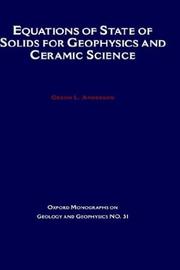
ISBN: 1280440597 9786610440597 142373467X 0195345274 1602565996 9781423734673 9781602565999 9780195056068 019505606X 0197560091 Year: 2023 Volume: 31 Publisher: New York : Oxford University Press,
Abstract | Keywords | Export | Availability | Bookmark
 Loading...
Loading...Choose an application
- Reference Manager
- EndNote
- RefWorks (Direct export to RefWorks)
Equations of state are of fundamental importance in studying the physics and chemistry of the Earth. This introduction to equations of state has many applications to ceramic sciences and solid Earth geophysics. Oxides and silicates, especially those with high density, are also examined.
Geophysics. --- Equations of state. --- Thermodynamics. --- Chemistry, Physical and theoretical --- Dynamics --- Mechanics --- Physics --- Heat --- Heat-engines --- Quantum theory --- Geological physics --- Terrestrial physics --- Earth sciences --- Equation of state --- Matter --- Properties --- Geophysics --- Equations of state --- Thermodynamics
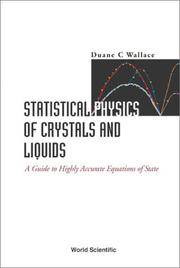
ISBN: 1281871842 9786611871840 9812388826 9789812388827 9781281871848 9789812381125 9812381120 9789812381132 9812381139 9812381120 9812381139 Year: 2002 Publisher: River Edge, NJ : World Scientific,
Abstract | Keywords | Export | Availability | Bookmark
 Loading...
Loading...Choose an application
- Reference Manager
- EndNote
- RefWorks (Direct export to RefWorks)
This important book presents a unified formulation from first principles of the Hamiltonian and statistical mechanics of metallic and insulating crystals, amorphous solids, and liquids. Extensive comparison of theory and experiment provides an accurate understanding of the statistical properties of phonons, electrons, and phonon - phonon and electron - phonon interactions in elemental crystals and liquids. Questions are posed along the following lines: What is the "best" theory for a given property? How accurate is a good theory? What information is gained by a comparison of theory and experiment? How accurate is a good experiment?
Equations of state. --- Crystals --- Liquids --- Statistical physics. --- Physics --- Mathematical statistics --- Fluids --- Permeability --- Polywater --- Crystallography --- Powders --- Solids --- Equation of state --- Chemistry, Physical and theoretical --- Matter --- Statistical methods. --- Statistical methods --- Properties --- Equations of state --- Crystals - Statistical methods --- Liquids - Statistical methods --- Statistical physics --- Equations d'état --- Physique statistique
Book
ISBN: 3036558705 3036558691 Year: 2022 Publisher: Basel MDPI - Multidisciplinary Digital Publishing Institute
Abstract | Keywords | Export | Availability | Bookmark
 Loading...
Loading...Choose an application
- Reference Manager
- EndNote
- RefWorks (Direct export to RefWorks)
The theory of quantum chromo dynamics (QCD), an organic part of the standard model (SM) of particle physics, has been validated by many theoretical and experimental studies. The strongly coupled QCD dynamics controls colored particles’ (quarks and gluons) collective motion at large spacetime separations and the formation of colorless composite states (hadrons). While QCD theory and the related phenomenology aspects are being intensively studied in laboratory measurements, the possible connections of this important layer of knowledge to cosmology remain rather vague and largely unexplored. No doubt, the physical vacuum has been transformed many times throughout the lifetime of the universe and has affected its history through a sequence of events, such as the cosmic inflation, phase transitions, and the dark-energy-dominated expansion. Strong interactions could play an important role in some of these cosmological events. In particular, the emergence of a new state of matter called the quark-gluon plasma at the LHC is often suggested to provide an important source of empirical knowledge to what the universe looked like in the first few moments after the Big Bang. This Special Issue aims at creating an overview of the recent progress in these directions by focusing on the novel implications of quantum chromo, or more generally, Yang–Mills (YM) dynamics, to the physics of the early universe and critical phenomena in cosmology.
Research & information: general --- Physics --- dynamics of phase transitions --- spinodal instability --- heavy-ion collisions --- neutron stars --- dark energy --- non-Abelian gauge theory --- condensate --- QCD --- DGLAP equations --- physics beyond the standard model --- tensorgluons --- extended DGLAP equations --- tensorgluon splitting functions --- neutron star --- equation of state --- many-body methods of nuclear matter --- neutron-skin thickness --- GW170817 --- Weyl gravity --- renormalization group --- inflation --- light scalar fields --- axial anomaly --- SU(2) Yang–Mills thermodynamics --- de-percolation of axionic lumps --- cosmological and galactic dark-matter densities --- cosmology --- particle physics --- particle symmetry --- stable particles --- dark matter --- cosmic rays --- QCD in the early universe --- phase transitions --- hydrodynamical evolution --- equation of state of super-dense matter --- classical Yang-Mills fields --- Dark Energy --- Dark Matter --- gluon condensate --- effective Yang-Mills action --- cosmic inflation --- n/a --- SU(2) Yang-Mills thermodynamics --- Research. --- Physics.
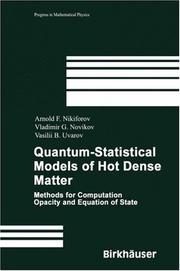
ISBN: 128026375X 9786610263752 3764373466 3764321830 Year: 2005 Publisher: Basel ; Boston : Birkhauser Verlag,
Abstract | Keywords | Export | Availability | Bookmark
 Loading...
Loading...Choose an application
- Reference Manager
- EndNote
- RefWorks (Direct export to RefWorks)
In the processes studied in contemporary physics one encounters the most diverse conditions: temperatures ranging from absolute zero to those found in the cores of stars, and densities ranging from those of gases to densities tens of times larger than those of a solid body. Accordingly, the solution of many problems of modern physics requires an increasingly large volume of information about the propertiesofmatterundervariousconditions,includingextremeones. Atthesame time, there is a demand for an increasing accuracy of these data, due to the fact thatthereliabilityandcomputationalsubstantiationofmanyuniquetechnological devices and physical installations depends on them. The relatively simple models ordinarily described in courses on theoretical physics are not applicable when we wish to describe the properties of matter in a su?ciently wide range of temperatures and densities. On the other hand, expe- ments aimed at generating data on properties of matter under extreme conditions usually face considerably technical di?culties and in a number of instances are exceedingly expensive. It is precisely for these reasons that it is important to - velop and re?ne in a systematic manner quantum-statistical models and methods for calculating properties of matter, and to compare computational results with data acquired through observations and experiments. At this time, the literature addressing these issues appears to be insu?cient. If one is concerned with opacity, which determines the radiative heat conductivity of matter at high temperatures, then one can mention, for example, the books of D. A. Frank-Kamenetskii [67], R. D. Cowan [49], and also the relatively recently published book by D.
Quantum statistics. --- High temperature plasmas. --- Equations of state. --- Plasma density. --- Density, Plasma --- Plasma (Ionized gases) --- Equation of state --- Chemistry, Physical and theoretical --- Matter --- Hot plasmas --- Plasmas, High temperature --- Gases at high temperatures --- Quantum statistical mechanics --- Matrix mechanics --- Statistical mechanics --- Wave mechanics --- Properties --- Physics. --- Condensed matter. --- Condensed Matter Physics. --- Natural philosophy --- Philosophy, Natural --- Physical sciences --- Dynamics --- Condensed materials --- Condensed media --- Condensed phase --- Materials, Condensed --- Media, Condensed --- Phase, Condensed --- Liquids --- Solids
Book
ISBN: 3036554009 3036553991 Year: 2022 Publisher: MDPI - Multidisciplinary Digital Publishing Institute
Abstract | Keywords | Export | Availability | Bookmark
 Loading...
Loading...Choose an application
- Reference Manager
- EndNote
- RefWorks (Direct export to RefWorks)
Following new developments in the measurement of gravitational waves from neutron–star mergers and the modification or construction of particle colliders to reach larger densities, we are entering a new era, during which we can begin to understand dense and hot matter for the first time. This, together with future supernova explosion data, will provide us with the opportunity to have truly multimessenger data on hot and dense matter, which is, to some extent, similar to the matter present in the core of proto-neutron stars. This Special Issue focuses on the theory necessary to understand present and future data. It includes state-of-the-art theoretical models that describe dense and hot matter and dynamical stellar simulations that make use of them, with the ultimate goal of determining which degrees of freedom are relevant under these conditions and how they affect the matter equation of state and stellar evolution.
Research & information: general --- Physics --- neutron stars --- equations of state --- relativistic models --- gravitational waves --- neutron star --- equation of state --- universal relation --- hybrid star --- color superconductivity --- diquark --- dense matter --- neutrinos --- hyperons --- nuclear matter --- neutron star merger --- beta equilibration --- weak interaction --- n/a --- chiral symmetry --- axion QED --- quark–hole pairing --- cold-dense QCD --- magnetic DCDW --- quark stars --- dark matter --- radial oscillations --- nuclear matter aspects --- quark deconfinement --- quark-gluon plasma production --- phase-transition --- neutron star crust --- meson interactions --- quantum molecular dynamics --- quark-hole pairing
Book
ISBN: 3039219596 3039219588 Year: 2020 Publisher: MDPI - Multidisciplinary Digital Publishing Institute
Abstract | Keywords | Export | Availability | Bookmark
 Loading...
Loading...Choose an application
- Reference Manager
- EndNote
- RefWorks (Direct export to RefWorks)
The book edition of the Universe Special Issue “Compact Stars in the QCD Phase Diagram” is devoted to the overarching aspects shared between heavy-ion collisions and compact star astrophysics in investigating the hadron-to-quark matter phase transition in the equation of state of strongly interacting matter in different regions of the phase diagram of QCD. It comprises 22 review and research articles that, together, will serve as a useful guide in educating both young and senior scientists in this emerging field that represents an intersection of the communities of strongly interacting matter theory, heavy-ion collision physics and compact star astrophysics.
Gamma-ray bursts --- collective flow --- vector interaction --- quarks --- meson production --- ? meson condensation --- neutrino --- magnetic DCDW --- pulsars --- light cluster emission --- monte carlo simulations --- neutron stars --- chiral symmetry --- GW170817 --- stellar structure --- supernova explosions --- maximum mass --- mass-radius relation --- nuclear equation of state --- in-medium effects --- Beth-Uhlenbeck equation of state --- speed of sound --- gravitational waves --- relativistic heavy-ion collisions --- crystalline structure --- neutron star --- finite density --- transport theory --- stellar evolution --- neutron star matter --- hadronic matter --- general relativity --- critical point --- ? resonances --- QCD matter --- modified excluded-volume mechanism --- cold-dense QCD --- quark stars --- quark-hole pairing --- finite size --- mass-twin stars --- pasta phases --- hybrid stars --- cluster virial expansion --- finite temperature --- quark-hadron phase transition --- hadron–quark continuity --- stellar magnetic field --- strangeness --- quark-gluon plasma --- pulsars: PSR J0737 ? 3039A --- pulsars: general --- combustion --- Mott dissociation --- hybrid compact stars --- quark deconfinement --- quark matter --- Gravitational waves --- pulsars: PSR J1757 ? 1854 --- neutrino emissivities --- directed flow --- star oscillations --- quark-hadron matter --- QCD phase diagram --- phase transition --- equation of state --- nuclear matter --- nuclear symmetry energy --- hydrodynamics --- deconfinement --- stars: neutron --- axion QED --- Quantum Chromodynamics --- dense matter --- heavy-ion collisions
| Listing 1 - 10 of 28 | << page >> |
Sort by
|

 Search
Search Feedback
Feedback About UniCat
About UniCat  Help
Help News
News